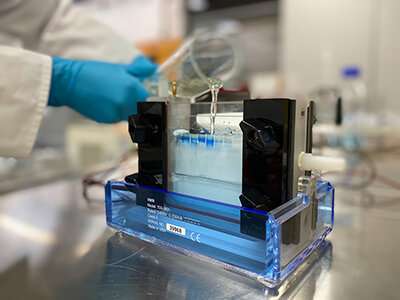Air purification and disinfection: New type of ventilator for virus-free air

The danger of becoming infected with the coronavirus is especially high in enclosed spaces. This is because aerosols—which play a key role in the transmission of COVID-19—increase the concentration of SARS-CoV-2 in indoor spaces. A new ventilation system developed by two Fraunhofer Institutes is able to filter the virus from ambient air. It then destroys the virus in a process known as cold combustion, leaving behind nothing but small quantities of carbon dioxide and hydrogen.
With the advent of winter, life has moved back indoors—and, with it, the danger of catching the coronavirus in schools, offices and shopping malls. A ventilator that reduces the danger of infection could play a significant role in combating the coronavirus. In a project known as CoClean-up, the Fraunhofer Institute for Ceramic Technologies and Systems IKTS in Dresden and the Fraunhofer Institute for Toxicology and Experimental Medicine ITEM in Hannover have now developed such a solution. This new system filters pathogens from ambient air and destroys them, leaving behind nothing but the nontoxic gas CO2.
While there are already filter systems that clean ambient air, these merely capture the virus rather than destroy it. Failure to exchange the filter may result in a perforation in the used filter, which in turn can lead to a major discharge of the virus into the room. Swapping filters can also pose problems. How best to remove the spent filter and then safely dispose of it along with its virus load? UV filters are one alternative. These do destroy most of the virus, yet the process involved can often create other harmful substances. In other words, they offer a partial solution at best.
At first glance, there is little to distinguish the Fraunhofer ventilator from existing systems. The process behind it, however, is completely new. “Our ventilator system fully destroys viruses and any other organic material,” says Hans-Jürgen Friedrich, group manager at Fraunhofer IKTS. “The only thing left are small quantities of CO2 and hydrogen. In other words, our process really does knock out the coronavirus.”
The virus is oxidized to CO2
In place of the filter found in conventional ventilators, the new system uses a process of cold combustion to remove the virus. Ambient air is fed through a saline solution, which filters out the virus and any other organic particles. The cleaned air is then released back into the room. In the saline solution are two electrodes, across which a voltage is applied. At one electrode, the organic substances in the saline solution—in-cluding any viruses—are fully oxidized to form CO2, in a process also known as cold combustion; at the other, small quantities of hydrogen are produced. In a room of normal size containing a fair number of people, this would only produce a couple of hundred milliliters of CO2 and hydrogen over the course of several hours. These two gases then disperse throughout the entire air within the room. By way of comparison, each liter of air exhaled by a person—the equivalent of one breath—contains around 40 milliliters of CO2.
At present, research teams are carrying out tests with unharmful substances. “For safety reasons, we don’t use the actual coronavirus for the tests,” explains Dr. Katharina Schwarz, head of department at Fraunhofer ITEM. “Instead, we use surrogates with very similar properties.” In tests at Fraunhofer IKTS, these surrogates were added directly to the saline solution. Researchers then analyzed the decomposition of this biological material at the electrodes and measured how much of it remained in the cleaned air discharged by the system. This demonstrated that the various electrolytic processes—i.e., the key part of the system—function as required.
In subsequent tests, the researchers will create an aerosol laden with the virus and pump this into the saline solution. Here, too, they will use less harmful surrogates. “To the best of my knowledge, there is no standardized procedure anywhere in Europe for using an airborne aerosol of a dangerous virus in order to test the effectiveness of air purification and air disinfection systems,” Schwarz says.
Looking at aerosols more closely
In another project funded by the Fraunhofer-Gesellschaft, Schwarz is working with healthy test subjects to investigate how the aerosol composition of exhaled air changes according to whether the person breathes normally or speaks, coughs and sings. Equipped with this knowledge, she plans to produce different types of aerosols, which will then be loaded with the virus and fed into the electrolytic cell. “But we have to be careful that the artificially produced aerosols don’t damage or decompose the test viruses,” she explains. “The key is to find a good balance.”
Source: Read Full Article
